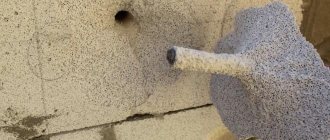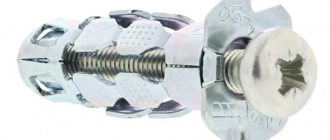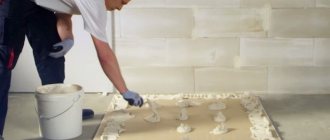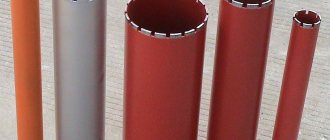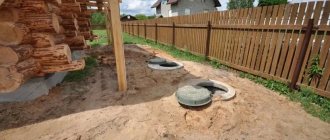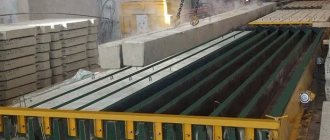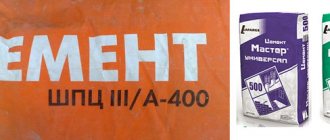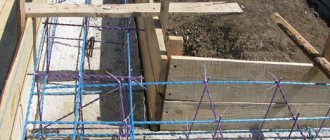During installation work, thermal insulation materials are secured using so-called mushrooms/umbrellas. They mean plastic fasteners with a flat round head. The design holds sheets of polystyrene foam, polystyrene foam, mineral wool well - the insulation can be attached to any wall/ceiling, be it brick, slag or ordinary concrete. The design of the element involves two parts - the central one (wedge) is made of metal; alternatively, it can be made of polyamide. Low-density polyethylene is used to make the dowel itself.
Disc-shaped dowel for fastening thermal insulation
Benefits of fungal fixatives
The widespread use of this option for fastening insulation is due to the following advantages:
- The wide cap ensures reliable fixation of any insulation. The inside of the cap is rough, which also further helps secure the material to the wall.
- The product implies the presence of an expansion washer, which can increase the contact area between the fungus umbrella and the insulating plate from 60 to 100 mm.
- The fastener has a long leg with good load-bearing capacity; it is also reliable due to spacers of three sections.
- Modern plastic dowels are a modified version of wooden plugs and do not have all the disadvantages that wood products have. In particular, plastic does not rot, does not suffer from mold, temperature changes, and this artificial material is cheaper.
- Reliability of fastening structures in the wall is ensured by screwing in a wedge - it pushes the walls of the anchor in all directions. This ensures the fixation of the dowel in the wall.
Peculiarities
The disc dowel can be visually divided into three conventional parts - the head, the ordinary probe of the rod and the spacer zone. A distinctive feature of the disc dowel head is its width with a diameter of 45 to 100 mm. This design solution allows you to reliably fix the insulation to the facade of the building. The cap has a rough surface and is equipped with cone-shaped technological holes to increase adhesion to the insulation. Under the cap there is a row zone of the rod, ending with a spacer zone, which is responsible for fastening the entire thermal insulation system to the facade and consists of several sections. The length of the section depends on the size of the disc dowel itself and averages 60 mm. The disc dowel also includes an expansion nail or screw, which secures the dowel by expanding the expansion zone.
Design
The high complexity of the insulation, or, more precisely, the combination of the heat- and waterproofing layer, has given rise to 2 main types of fastening, which are divided into groups according to their purpose.
- dowel for facade thermal insulation and wall insulation;
- fasteners for roofing thermal insulation.
The first has a well-known appearance: because of the wide pressure disk, it is called a disc or mushroom. This design can be one-piece - actually a dowel with a head, or it can be collapsible. The latter consists of several elements:
- sleeve with spacer part. When fastening, the smooth non-expanding part ends up in the thickness of the insulation, and the expansion part ends up in the durable material of the wall or ceiling;
- the head in the form of a pressure disk is integral with the dowel;
- rod - when driven, it bursts the sleeve.
In fact, except for the large volume of the head, the dowel for insulation is no different from a regular one.
The disc diameter ranges from 45 to 90 mm. In some cases, an additional disk is put on the dowel - a rondole, with a diameter of up to 140 mm.
Dowel device for fastening insulation
Advantages and disadvantages
In the vast majority of cases, plastic fasteners are used.
- Firstly, the insulation is a light and loose material, and does not create a high load.
- Secondly, the metal rod, while increasing the strength of the connection, unfortunately, creates a cold bridge. The thermal conductivity of metal is much lower than plastic and it literally conducts cold through the insulation. To avoid this, steel nails for dowels with a thermally insulated head are produced.
The second type of dowel for roof insulation is telescopic. It is a hollow plastic rod with a wide pressure disk. It is mounted somewhat unusually: it is installed in the body of a heat insulator, or, more accurately, a roofing pie, and a nail or anchor passes through the rod and is immersed in a dense material - concrete, corrugated sheeting.
Selection factors
When choosing a product, you need to pay attention to a number of factors.
- The main one is sufficient length . It consists of the thickness of the thermal insulation and other layers, the thickness of the adhesive composition, the amount of deviation of the wall from the vertical and the minimum possible recess.
- Pull-out load - no matter how light the heat insulator is, it still has weight, and each fastener is designed for a certain load. In this case, it is necessary to take into account the working load, and not the maximum. Thus, the maximum load for a polypropylene dowel is 60–150 kg. However, the working level can only reach 25%, which equates to 15–37 kg.
Types of dowels
All the needs of the construction market are met by three types of umbrella designs - their main difference is the anchor material.
Made from galvanized steel
Metal fungi
The metal dowel for attaching insulation is characterized by increased strength compared to its polymer counterparts. But its use is limited by the high thermal conductivity of the metal, which negatively affects the efficiency of the heat-insulating layer.
A steel dowel becomes a cold bridge, which reduces the overall thermal conductivity of the entire structure. Despite the presence of galvanization, models with a metal core are inevitably subject to corrosion, stains of which can appear even through the plaster on the facade, which spoils the entire exterior. The cost of a dowel with a metal nail is one and a half times more than a plastic one.
Made of plastic
Plastic umbrellas
Plastic elements for fastening insulation to the wall are made of polyamide, nylon and polypropylene. This determines their main advantage - their low price, while their strength characteristics are not up to par.
This type of fastener for thermal insulation can be used on concrete surfaces; alternatively, a plastic insulation fastener does a good job of fixing the mineral wool to a brick wall.
If the insulation is heavy enough and the wall is made of foamed concrete or has cavities, then it is better not to use plastic umbrellas.
With thermal head
Dowel with a thermal head
Models with a thermal head are superior in properties to metal dowels, since the head itself has low thermal conductivity and does not have the disadvantages inherent in metal products. The coating is made of impact-resistant polyamide, the thermal conductivity of which does not exceed the thermal conductivity of the insulation itself.
Since the metal is completely covered with a polymer cover, the design does not create cold bridges and does not reduce the overall thermal conductivity of the heat-insulating layer, and at the same time does not corrode, since its polymer is a reliable protection against moisture. The only drawback of such fungi is their high cost, which can be one and a half times higher than umbrellas with a steel anchor.
The main advantages of the disc mount
When installing any thermal insulation material, special dowels are used - they are called heat insulator mushrooms or umbrellas. Such products are capable of reliably fixing even material that is characterized by fragility or low density.
Using such fungi, you can attach a heat insulator to concrete, stone, brick and other materials.
As a rule, the fungi are made from low-pressure PE (or HDPE for short), while the wedge can be made from polyamide or galvanized. The main advantages of the described element are given below.
- Umbrellas owe their widespread use to their special design: their outer cap is wide enough, thanks to which any insulation (up to mineral wool) is securely fixed.
- Having a long leg, the umbrella is able to withstand very significant load-bearing loads. Moreover, the fastening is enhanced by the long spacer zone, which therefore consists of 3 sections. The cap itself is somewhat rough, and there are also special holes on it.
- Dowels for heat insulation not only contribute to heat conservation, but also have increased anti-corrosion qualities. And if you compare them with the already outdated corks made of wood, then polyethylene umbrellas do not rot or destroy.
- Plastic is a reliable and durable, but at the same time cheap material.
- The umbrellas themselves are flexible enough to level out the narrowing/expansion of the surface in order to avoid damage to the insulation.
- To make the connection as reliable as possible, the fungus inserted into a special hole using a wedge must be opened. What is characteristic is that the expansion occurs in all directions at once, due to which the adhesion to the working surface only increases.
How to calculate the thickness of insulation
Previously, we talked about how to calculate the required thickness of insulation at home; in addition to this article, we advise you to read this information and read about it here
Fungus sizes
The parameters of disc elements from different manufacturers may differ, since there is no single GOST that would regulate the size of such products.
You can only specify general values:
- the diameter of the mushroom cap for attaching the insulation varies from 45 to 90 mm;
- the diameter of the rod can be 8 or 10 mm;
- length range is 40-400 mm.
Dowels are available in different sizes.
Depending on the size, wedge material and wall material, the load on the fungus can range from 0.3 to 23 kN.
Operating principle
Despite the fact that technical progress is advancing by leaps and bounds, and building materials are constantly being improved, the dowel described here (or a fungus for attaching insulation) is attached in the same way as before - it holds due to the fact that the holding force of friction acts on it. It is worth noting that this force is so significant that it is not for nothing that this fastening method is called disposable: if you remove the umbrella from the hole, it will simply collapse.
Of course, there is another way to hopelessly damage an element - you just need to tear it out along with the insulating material. To avoid all this, it is imperative to ensure that the seating area is arranged correctly. It is important that the hole for the umbrella fully corresponds to the required depth and diameter. Chips and cracks in the holes are unacceptable, as is the presence of installation dust in them.
Insulation with foil
Previously, we talked about the advantages of insulating material with foil, its technical characteristics and cost, in addition to this article we advise you to read this information, read about it here
Calculation of the number and length of dowels
When choosing the parameters for attaching the insulation to the wall, you can not pay attention to the load-bearing load, since due to its looseness, the density of the insulation is significantly less than the similar characteristics of the walls and ceiling.
This parameter is indicated in the documents for hardware, in particular, the pull-out load. In practice, this data is not used when choosing a product.
Parameters of IZL-T disc dowels
The following parameters are considered important:
- Length - when choosing the length, it is worth considering not only the thickness of the insulation and all other existing layers (glue, vapor and waterproofing, wall unevenness), the dowel must penetrate the wall to the minimum allowable amount. This value is different for each building material. The parameters of hollow and cellular concrete and brick are different - they are indicated in the certificate, which must be studied.
- The diameter of the disc element should be larger, the more loose the material is attached to the wall or ceiling. Dense foam plastic can be fixed with an umbrella with a small head, while mineral wool requires the largest discs.
- The number of umbrellas directly depends on the installation scheme - often 5 elements are required for one insulation plate - fastening is carried out in the corners and in the center. Well, if the insulation is attached to the facade, then the number of fungi is calculated based on the consumption per plate (1 sq. m.). The number of dowels in one plate directly depends not only on the size of the plate itself, but also on the wind load. Therefore, when installing insulation on a facade, from 7 to 9 fungi per square meter are used, which depends on the height of the building and the wind rose.
Product characteristics
Polypropylene plastic dowels are widely in demand; it is profitable to purchase them in large quantities for resale, as they will cost much less. It is widely used by construction companies and teams who, by purchasing this product in bulk, can ensure uninterrupted work for their employees. It is always bad for any employer when construction workers are idle due to a lack of material. The propylene dowel and nail for insulation is especially valued for its corrosion resistance; you can be one hundred percent sure that it will not rust, which is why stains usually appear on the facade, which spoil all the work done. The products have different lengths and diameters, which allows them to be used for fixing a particular material. They come in the following sizes, which are especially in demand:
Installation of material using an umbrella
Installation work is an intermediate stage in finishing the interior or exterior. In any case, consider all the features of the surface to which the material is attached.
If the wall is loose and cracking, you need to take this into account when calculating the penetration depth or simply cut the wall down to a solid base.
Installation of the disc dowel is carried out as follows:
- We fix the insulating material with glue - this is true for polystyrene foam and polyurethane foam, and mineral wool is fixed with lathing.
- We mark the places for fastening on the plates, after which it is necessary to drill holes at the indicated points - their depth should be 15 mm greater than the calculated value. Spare centimeters are needed so that the dowel is guaranteed to fit to a certain depth, because there is no way to clear the hole of debris. The depth is calculated not from the surface of the insulation, but from the beginning of the wall surface.
- We insert the dowel into the hole, then drive in a wedge - the head of the metal pin must be closed with a cap.
Obviously, the process of installing disc elements for fixing thermal insulation materials is not difficult - this work can be handled without the appropriate skills and experience.
Types of fasteners for thermal insulation.
The mushroom dowel for attaching insulation can be plastic or steel. Its type depends on the insulation with which builders have to work. Also, dowels differ from each other in the type and quality of production, and in their configuration. The design may include a thermal head.
Features of plastic fasteners
There are cone-shaped holes on the surface of the umbrella.
This design feature provides additional adhesion to the material. For installation of non-solid materials, nylon fasteners are used, which are made from high-strength polypropylene, nylon, and polyamide. The features of such fungi include:
- lack of response to temperature changes;
- low cost;
- reduced thermal conductivity;
- impeccable stability in extremely harsh conditions;
- long service life due to the absence of rot and rust;
- load bearing capacity of 400 kg/m2.
Plastic fungi are widely used for insulating walls made of brick and concrete.
Metal fasteners
The internals of the metal fasteners are made of steel. The sleeve used is polypropylene, at the end of which there are spacers. With this type of fastener, a high degree of load is allowed. Telescopic fasteners TechnoNIKOL are used for arranging the facade. The disadvantages of the material include:
- high price;
- the occurrence of condensation at the entry point of the metal rod;
- possible rust (metal parts come into contact with moisture, rust may appear on the plaster).
Thermal Head Fasteners
It is a metal rod, which is coated with polyamide near the cap. This plastic part prevents condensation from accumulating at the fastening points, thereby preventing rust from appearing on the plaster.
These devices are mainly used for insulating wooden houses. The advantages of these fungi are similar to the positive properties of plastic and metal fasteners. The disadvantage of the product is the high price, which surpasses everything in this segment.
Fastening requirements
Insulation anchors are subject to high stress, function in alkaline environments and are exposed to extreme temperatures. This means they must meet several criteria.
- Be resistant to destruction. Both the umbrella itself and the nail must be of very high strength. The nail must be made of galvanized steel so that its material does not react and begin to deteriorate. This is especially important when the material under the “wet facade” is attached with fungus. With this approach, the fungus is covered with a layer of plaster and becomes “immured” in alkali.
- When passing through thermal insulation, the fungus can become a “cold bridge.” This will not happen if the material from which the fastener is made has low thermal conductivity. A thermal conductivity index higher than 0.004 W/K is considered unacceptable.
- Ensure high adhesion. In the case of ventilated facades, fungus often serves as the only retaining factor for thermal insulation. “Wet” ones also contain foam adhesive, but the load is much higher. The fungus must provide sufficient adhesion to the surface of the insulation and the main material of the wall. In addition, if foam or fiberglass insulation is reinforced with an adhesive layer on top, the cap must become one with this wet compound, providing a layer of insulation.
We have set the basic requirements for fasteners for insulation; now it is important to see how the modern market satisfies these requirements.
Video text
Mixtures for facades and glue for penoplex here - https://goo.gl/scmdUv How to attach penoplex to the wall! The more videos we make, the more topics are reflected on our all-knowing channel. And don’t say anything, but the topic of facade insulation, and simply wall insulation, will always be relevant, because we live in snowy Russia, and not on the hot Canary Islands! And there, for example, our eighty-seventh (No. 87) video - “How to attach penoplex to the wall”, hardly any beachgoers started watching about penoplex! And in our cold expanses they will! Right?! Briefly about penoplex itself. This is a special type of expanded polystyrene (a close relative of polystyrene foam) - extruded or extruded. A material with amazing thermal insulation properties. You can mount it both inside your favorite apartment, or maybe a country house, or outside on an ever-freezing facade. And you, the audience, should not be frightened by either concrete walls, wooden partitions, or classic brick ones. Penoplex or technoplex will insulate everything correctly, as required by the Russian winter! Max will show you how to attach it in this video! Let's look at the fastening of extruded polystyrene foam (the so-called penoplex-technoplex), and get ready to insulate the walls! Winter is coming, but a video on how to attach this type of foam is just around the corner! Inside our channel!
And the channel from Volgograd has a new exciting video about attaching penoplex to the concrete walls of Brezhnevka - https://www.youtube.com/c/Guysstone Kraftool facade spatulas for insulating penoplex on the outside of the facade - https://goo.gl/mW8Ur9 What if is on the channel, then on the page on your favorite VKontakte you can take a look at how to attach penoplex or polystyrene foam - https://vk.com/guysstone Our Instagram with photos from the world of repair and finishing - https://www.instagram.com /guys_stone_/
Then it would be logical to familiarize yourself with our other videos on the given topic of penoplex (technoplex) and winter insulation: No. 25 – How to fix drywall and with what –
No. 27 – How to use a hammer drill without angering your neighbors -
No. 34 – How to insulate a wall with mineral wool. and not penoplex -
Kraftool facade spatulas for insulation with penoplex outside the facade - https://goo.gl/K4T2EL
Insulating walls with penoplex is correct and reliable. What's outside, what's inside. On the floor, on concrete, on wood or penofol with drywall.
How to fix penoplex to the wall! The more we remove the video, the more those are reflected in our omniscient channel. And what it does not say, but the theme of the facade thermal insulation, and a wall insulation, will always be true, because we live in the snow Russia, rather than the hot Canary Islands! And there, for example, our eighty-seventh (No. 87) Video – “How to fix penoplex to the wall”, hardly anyone from beachgoers turned pro penoplex watch! And will our Frigid open spaces! Correctly?! Briefly about the Penoplex. This is a special kind of polystyrene (Styrofoam native relative) – extrusion or extruded. A material with amazing insulating properties. #Penoplex #Expanded polystyrene #Facade
Famous manufacturers
Leading manufacturers of dowels for insulation are companies from Germany, Russia and Poland. The most famous companies include:
- Termoklip. The company supplies products to Russia and the CIS countries, made of carbon steel with anti-rust coating. Dowels of several series are produced, made from block polymer. Some models have a heat-insulating cover.
- Isomax. Produces disc dowels with a diameter of 10 mm. The nail is made of carbon steel with galvanized coating. It is possible to install a thermal head.
- Tech-Krep. The Russian manufacturer supplies plastic fasteners in different designs. They may have a plastic or metal nail or a thermal cover. They have a complex chemical composition. The steel nail has a galvanized coating.
All products have the necessary certificates and licenses for installation work.
Installation
The installation of thermal insulation using disc dowels is a very simple process. It consists of a list of the following works:
- Marking the area for installation.
- Drilling holes at right angles for fastening together with thermal insulation.
- Installation until the disc fungus is completely adjacent to the insulation.
- Driving a nail for expansion and final fastening.
- Attaching a nail-protecting cap.
Before fixing the thermal insulation, you need to either remove the old layer of plaster or increase the drilling depth. For ease of use, the heat-insulating material is first glued to the walls with a special adhesive, allowed to dry, and only then the dowels are installed.
The hole for fastening is made 8 - 10 mm wide. The depth should be 60 mm for a 50 mm anchor component, and 110 mm for this 100 mm component.
After attaching the thermal insulation material, there remain fairly deep holes that need to be sealed using a paint spatula. To do this, you can use the same solution as for gluing the insulation.
Advice . If you decide to reduce the length of the spacer, be sure to sharpen the truncated end.
Today, the dowel for thermal insulation is the main fastening system offered on the building materials market. The leading manufacturers in this area are Russian, Polish and German enterprises. To ensure high-quality insulation of your home, it is better to purchase products from these countries.
How to firmly attach insulation to any wall
There are 3 main methods for attaching to the walls of a building.
I – sheathing. They create a frame base for ventilated cladding. To do this, choose galvanized metal profiles that are resistant to corrosion and temperature changes.
II – glue. Bonding thermal insulation material has subtleties. First, you need to choose a suitable composition that meets all the requirements. The second is moisture resistance. Further, insulation is rarely simply “set” on glue. Additionally, umbrella dowels are used.
There are 2 types of glue:
- dry mixture;
- glue-foam.
The first type is released in bags. It is diluted according to the instructions on the package. Adhesive foam is produced in cylinders. It does not need to be diluted with water or stirred. Application is carried out using a construction gun.
To fix the thermal insulation, it is necessary to carry out preparatory work. The surface must be cleaned of dust and leveled by applying a layer of plaster.
III – use of dowels. This is the main method for firmly fixing thermal insulation. Dowels are used for both additional and primary fixation.
Each method has its own nuances and features. Before choosing a fixation method, you need to assess the wall surface, as well as compare the factors affecting the materials (temperature, humidity, frost resistance).
Mineral or stone wool
To lay mineral wool, create a sheathing of wooden beams.
The distance between the slats should be less than the size of the wool. In this case, the cotton wool will adhere to the base and hold on.
If the thermal insulation is purchased in slabs (it is stiffer), then the slats are filled in a cellular manner.
The wool in the slabs can be glued or dowels can be used. But, the lathing is mandatory.
When using roll insulation, the slats are filled horizontally or vertically.
For lathing, slats are used in height greater than the thickness of the wool. This creates an air gap between the insulation and the finishing coating. This will increase the thermal insulation of the wall.
Penoplex
Penoplex is often used for insulating private houses and apartments at height. To fix it, glue and dowels are used.
To glue polystyrene foam, a flat surface coated with a primer is required. A support strip is stuffed at the bottom, and glue is applied to the foam sheets. After applying the sheet, you need to hold the material for a while so that the adhesive composition sets.
After the glue has set, holes are made in the sheet for dowels. They will create strength.
Polyurethane foam
This is a porous gas-filled polymer based on polyurethane components.
It has a number of distinctive properties, low thermal conductivity. Therefore, it began to be often used in cold regions. Water and sudden changes in temperature do not affect it. Polyurethane foam is produced as foam. Apply to the surface in 2 ways:
- spraying using equipment;
- pouring - special equipment is used for this and voids must be equipped.
The insulation warranty period is up to 50 years.
Prices
The cost of disc dowels (if we talk about Moscow and the Moscow region) is at least 1.5 rubles per unit.
You can save a little money by ordering in bulk. There is another way to reduce the final cost - for example, pickup.
Table. Average market prices for umbrellas
| Type of umbrellas | Plastic anchor | Iron anchor | Iron anchor and thermal head |
| Cost, in rubles per unit | 5,10 | 4 | 1,50 |
Installation work
The number of dowels is calculated based on the presence or absence of additional fasteners, for example, glue
First of all, you need to calculate how many dowels are needed, what their length and diameter should be. It depends on the insulation. Its weight is practically unimportant; the thickness and degree of looseness are important.
The length of the fastener for mushroom insulation depends on several parameters. The thickness of the insulation sheet, adhesive layer, vapor barrier, waterproofing. It is also necessary to take into account the deviation from the vertical and the maximum possible recess into the wall. All these criteria must be indicated in the documentation and the size is selected based on them.
The diameter of the cap is determined by the degree of looseness of the thermal insulation. This criterion is approximate; exact values are not indicated anywhere. If the thermal insulation is light and loose in structure, the diameter should be large. When laying foam plastic, you can choose dowels with a small head. For laying mineral wool, choose the largest caps.
The number of fasteners depends on the weight of the insulating boards and the possible load of the disc dowel itself for attaching the insulation. There should be at least 5 of them per plate - 4 are attached in the corners, 1 at the central point.
All these values apply if the inside of the house is insulated.
If thermal insulation will be attached to the facade, it is necessary to take into account the wind load. The number of fastenings increases; there should be at least 6 of them, located in two parallel rows. If the building has a height of up to 20 meters, per 1 sq.m. there are 7 dowels. At a height of more than 20 meters, the consumption of fasteners increases to 9 pieces.
Additional Tips
The fungi are placed at the joints of the sheets, this will help to avoid the presence of additional holes in the insulation. That is, with such work, the thermal insulation properties are preserved and cold bridges are not formed.
When installing a dowel into a metal coating, a self-tapping screw is attached to the rod of the fungus. Using a self-tapping element, the fastener is immersed in the heat-insulating material so that it reaches the main surface. Then the dowel is screwed into the metal surface with a screwdriver, the depth of the hole for the screw is made about 15 millimeters. When the installation of the thermal insulation material is completed and the sheets are properly secured, all connections are closed with aluminum tape.
With the right choice and counting the number of dowels, the penoplex will be securely fixed. Before you start fixing sheets with dowels, you need to calculate the number and required length of fasteners.
The choice of method for insulating buildings remains an urgent problem. When heat passes through walls unimpeded, heating efficiency decreases and costs rise. Penoplex sheathing is considered one of the simple and inexpensive methods of insulation. To save money, many people prefer to carry out repairs themselves. To perform high-quality insulation, you need to know how to properly attach penoplex to the wall.
